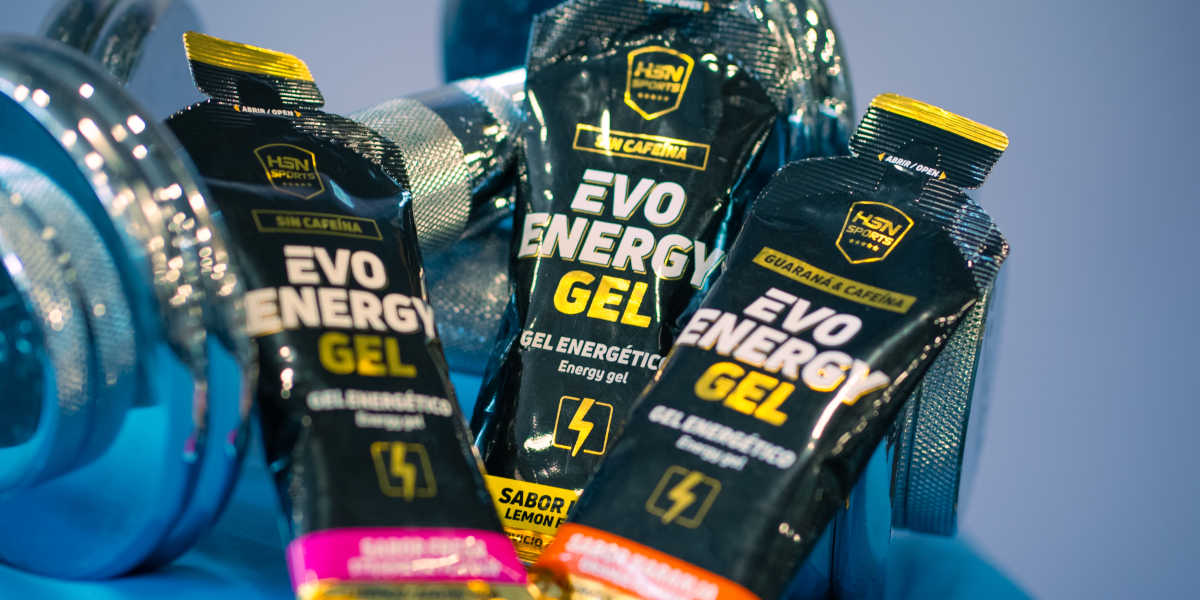

Featured
How Long Do Energy Gels Take To Kick In
Modified: August 19, 2023
Discover how long it takes for energy gels to kick in and fuel your workout. Read our featured guide on the effects and timing of energy gel consumption.
Introduction
When it comes to fueling endurance activities, such as long-distance running or cycling, energy gels have become a popular choice for athletes. These small packets of concentrated carbohydrates promise to provide a quick and convenient source of energy to keep you going during intense workouts or races. But how long do energy gels actually take to kick in?
Before we dive into the specifics, it’s important to understand what energy gels are and how they work. Energy gels are gel-like substances that contain a high concentration of easily digestible carbohydrates, usually in the form of sugars like glucose or fructose. They may also contain electrolytes, amino acids, and caffeine to provide an extra boost. These gels are designed to provide a rapid and easily absorbed source of fuel to the muscles.
Now, let’s explore how energy gels work to provide the necessary energy for performance enhancement. When you consume an energy gel, the carbohydrates in the gel are broken down into glucose, which is the primary source of energy for your muscles and brain. This glucose is then transported through the bloodstream to the working muscles, where it is converted into energy through a process called cellular respiration.
The time it takes for energy gels to kick in can vary depending on several factors. One of the key factors is the composition of the energy gel itself. Gels that contain a higher concentration of simple sugars like glucose tend to be absorbed more quickly, resulting in a faster release of energy. Conversely, gels with a higher amount of complex carbohydrates may take longer to kick in as they require more digestion and conversion into glucose.
Another factor that influences the time it takes for energy gels to take effect is individual variability. Each person’s digestive system may have varying rates of absorption and metabolism, which can affect how quickly the gel is broken down and the energy is released into the bloodstream.
Furthermore, factors such as exercise intensity, duration, and overall fitness level can also impact the rate at which energy gels take effect. During high-intensity activities, blood flow is directed away from the digestive system and towards the working muscles, potentially slowing down the absorption and digestion process.
In the next sections, we will delve deeper into digestion time and absorption of energy gels, as well as explore the typical time frame for energy gels to take effect.
What are energy gels?
Energy gels have become a staple in the world of endurance sports and activities. These small, portable packets are designed to provide a quick and easily digestible source of carbohydrates, electrolytes, and other nutrients to fuel the body during exercise.
Energy gels are typically made up of a mixture of carbohydrates, which can include simple sugars like glucose, fructose, and maltodextrin. These carbohydrates are quickly broken down in the body and converted into glucose, which is used as fuel by the muscles. The high concentration of carbohydrates in energy gels allows for a rapid release of energy, helping athletes to sustain their performance during long-duration activities.
In addition to carbohydrates, energy gels may also contain electrolytes such as sodium and potassium. These electrolytes help to maintain proper fluid balance in the body and prevent dehydration, which is especially important during prolonged exercise.
Some energy gels also contain amino acids, which are the building blocks of protein. Amino acids, such as branched-chain amino acids (BCAAs), can help to reduce muscle damage and promote recovery during and after exercise.
Caffeine is another common ingredient found in many energy gels. Caffeine is a natural stimulant that can enhance focus, alertness, and endurance performance. It works by stimulating the central nervous system and reducing the perception of fatigue.
Energy gels are designed to be consumed during exercise, typically every 30 to 45 minutes, depending on the individual’s needs and the duration of the activity. They are compact and easy to carry, making them a convenient fueling option for athletes on the go.
It’s important to note that energy gels should be consumed with water to aid in their absorption and prevent potential stomach discomfort. Without adequate fluid intake, the concentrated carbohydrates in the gel may not be properly digested and absorbed, leading to gastrointestinal issues.
Overall, energy gels are a popular choice for endurance athletes looking to sustain their energy levels and enhance performance during long-duration activities. Their convenient packaging and quick absorption make them a practical and efficient source of fuel, helping athletes push their limits and achieve their goals.
How do energy gels work?
Energy gels are specifically formulated to provide a quick and efficient source of energy for athletes during intense physical activities. But how do these gels actually work to fuel the body?
When energy gels are consumed, the carbohydrates present in the gel are broken down into glucose, which is the primary fuel source for muscles. This process, known as digestion, begins in the mouth with the enzyme amylase and continues in the stomach and small intestine.
Once the carbohydrates are broken down into glucose, they are absorbed into the bloodstream through the walls of the small intestine. From there, the glucose is transported to the muscles, where it is stored as glycogen or used immediately for energy production.
The quick absorption of energy gels is attributed to their high concentration of easily digestible carbohydrates. Simple sugars like glucose and fructose are rapidly absorbed by the body, providing a quick release of energy. This is particularly beneficial during endurance activities when the body’s glycogen stores become depleted, and a readily available fuel source is needed to sustain performance.
In addition to carbohydrates, energy gels may also contain electrolytes. Electrolytes are minerals that help maintain proper fluid balance in the body and play a crucial role in muscle function. During intense exercise, electrolytes are lost through sweat, and replenishing these electrolytes is essential to prevent dehydration and maintain optimal performance.
Some energy gels also include amino acids, such as branched-chain amino acids (BCAAs). BCAAs are known for their ability to reduce muscle damage and promote recovery. They help to prevent muscle breakdown during exercise and provide the necessary building blocks for muscle repair and growth.
Another common ingredient found in energy gels is caffeine. Caffeine acts as a stimulant, affecting the central nervous system and reducing the perception of fatigue. It can enhance focus, alertness, and endurance performance, making it a popular choice for athletes seeking an extra boost during their workouts or races.
Overall, energy gels work by providing a concentrated dose of carbohydrates, electrolytes, amino acids, and potentially caffeine to fuel the muscles during exercise. Their quick absorption and high-energy content make them a valuable tool for athletes looking to maintain their energy levels and improve performance during prolonged activities.
Factors affecting the time energy gels take to kick in
The time it takes for energy gels to kick in and provide a noticeable boost of energy can vary from person to person and depends on several factors. Understanding these factors can help athletes better time their gel consumption to maximize its effectiveness.
1. Composition of the energy gel: The specific formulation of the energy gel can impact how quickly it takes effect. Gels with a higher concentration of simple sugars like glucose tend to be absorbed more rapidly than gels with complex carbohydrates. Simple sugars are quickly broken down and can provide a near-instantaneous source of energy.
2. Individual metabolism and digestive system: Each person’s metabolism and digestive system may have different rates of absorption and digestion. Factors such as the efficiency of the digestive enzymes, the health of gut microflora, and any gastrointestinal conditions can influence how quickly the energy gel is processed and its nutrients are released into the bloodstream.
3. Exercise intensity and duration: The intensity and duration of the exercise can affect how quickly energy gels take effect. During high-intensity activities, blood flow is redirected away from the digestive system and towards the working muscles. This reduced blood flow to the gut may slow down the absorption and digestion of the gel, resulting in a slightly longer time for it to kick in.
4. Individual fitness level: Fitness level plays a role in how quickly energy gels are absorbed and utilized by the body. Well-trained athletes tend to have more efficient metabolic pathways, allowing for faster absorption and utilization of the carbohydrates in the gel. On the other hand, individuals who are new to endurance activities may experience a slightly longer delay before feeling the effects of the gel.
5. Hydration status: Proper hydration is important for optimal absorption and utilization of energy gels. To aid in digestion and absorption, it is recommended to consume energy gels with water. Inadequate hydration can lead to slower absorption and potential stomach discomfort, which may delay the onset of the gel’s effects.
6. Pre-existing conditions and medication: Certain medical conditions and medications may affect the absorption and metabolism of energy gels. It is always advisable to consult with a healthcare professional if you have any concerns or if you are taking medication that could interact with the gel’s ingredients.
It’s vital to note that the variations in how long energy gels take to kick in are generally minor. They can range from a few minutes to around 15-30 minutes, depending on the factors mentioned above. Athletes are encouraged to experiment during training to determine their own optimal timing for gel consumption.
Digestion time and absorption of energy gels
Understanding the digestion time and absorption of energy gels is essential for athletes to properly time their gel consumption and ensure optimal performance during endurance activities.
Energy gels are designed to be easily digested and rapidly absorbed by the body. The specific composition of the gel, including the type and concentration of carbohydrates, can impact how quickly it is broken down and its nutrients are absorbed.
After consuming an energy gel, the digestion process begins in the mouth, where the carbohydrates in the gel mix with saliva and start to break down. Once in the stomach, the gel is further broken down by digestive enzymes and hydrochloric acid. However, the stomach is not the primary site of absorption for carbohydrates.
The majority of carbohydrate absorption takes place in the small intestine. The carbohydrates are broken down into their simplest form, glucose, and then transported through the walls of the small intestine into the bloodstream. From there, the glucose is delivered to the working muscles to be used as fuel.
The time it takes for energy gels to be digested and absorbed can vary based on several factors. The type of carbohydrates used in the gel can influence the rate of digestion and absorption. Simple sugars like glucose and fructose are quickly broken down and absorbed, providing a rapid release of energy. On the other hand, complex carbohydrates like maltodextrin may take slightly longer to be broken down and absorbed.
Individual factors such as metabolism, digestive health, and exercise intensity can also impact the digestion and absorption of energy gels. People with efficient digestive systems and higher metabolic rates may experience quicker digestion and absorption, leading to a faster onset of the gel’s effects.
Hydration status plays a crucial role in the digestion and absorption of energy gels as well. Adequate hydration helps facilitate the breakdown of carbohydrates and the absorption of nutrients. Consuming the gel with water is recommended to aid in digestion and ensure optimal absorption.
It’s important to note that the digestion and absorption of energy gels occur relatively quickly compared to other fuel sources like solid foods. Generally, the digestion and absorption process takes approximately 15-30 minutes for the gel’s nutrients to be available for energy production.
To optimize the timing of energy gel consumption, it’s recommended to experiment during training sessions. Start by consuming an energy gel approximately 15-30 minutes before the anticipated need for a boost in energy. This can help ensure that the gel is fully digested and absorbed by the time it is needed to sustain performance.
Understanding the digestion time and absorption of energy gels allows athletes to strategically plan their fueling strategy and maximize the benefits of these convenient and effective fuel sources during endurance activities.
Typical time frame for energy gels to take effect
The time it takes for energy gels to take effect can vary depending on various factors, such as the composition of the gel, individual metabolism, exercise intensity, and hydration status. However, there is a typical time frame within which most athletes can expect to feel the effects of energy gels.
Generally, energy gels take approximately 15-30 minutes to kick in and provide a noticeable boost of energy. This time frame accounts for the digestion and absorption of carbohydrates from the gel, which are then converted into glucose and delivered to the working muscles for fuel.
It’s important to keep in mind that individual responses can differ. Some athletes may experience a faster onset of the gel’s effects, particularly if they have a fast metabolism and efficient digestion. Conversely, other individuals may take slightly longer to feel the effects, especially if their metabolism is slower or if they have pre-existing digestive issues.
The specific composition of the energy gel can also influence the time it takes to take effect. Gels with a higher concentration of simple sugars like glucose tend to be absorbed more rapidly, providing a faster release of energy. On the other hand, gels with a higher amount of complex carbohydrates may take a bit longer to kick in as they require more digestion and conversion into glucose.
Exercise intensity and duration can also affect the time it takes for energy gels to take effect. During high-intensity activities, blood flow is directed away from the digestive system and towards the working muscles. This shift in blood flow may slightly delay the absorption and digestion process, resulting in a slightly longer time for the gel to kick in.
Hydration status also plays a role in the effectiveness of energy gels. Adequate hydration helps with digestion and nutrient absorption. It is recommended to consume energy gels with water to ensure optimal absorption and effectiveness.
It’s important for athletes to experiment and determine their optimal timing for energy gel consumption during training sessions. By testing different time intervals, athletes can identify when they personally experience the most effective results based on their individual metabolism, digestive system, and exercise intensity.
Overall, while there is a typical time frame of 15-30 minutes for energy gels to take effect, it’s essential for athletes to listen to their bodies and adjust their gel consumption accordingly. By understanding the factors that influence the gel’s effectiveness and considering individual variations, athletes can make informed decisions about the timing of energy gel consumption to optimize their performance during endurance activities.
Conclusion
Energy gels are a popular choice for athletes looking to fuel their endurance activities. These concentrated packets of carbohydrates, electrolytes, and other nutrients provide a quick and convenient source of energy to sustain performance during long-duration exercises. However, the time it takes for energy gels to kick in can vary based on several factors.
The composition of the energy gel, including the type and concentration of carbohydrates, can influence how quickly it is absorbed and converted into usable energy. Gels with a higher concentration of simple sugars like glucose tend to be absorbed more rapidly, providing a faster release of energy.
Individual factors such as metabolism, exercise intensity, and hydration status can also impact the digestion and absorption of energy gels. Each person’s metabolic rate and digestive system are unique, which means that the time it takes for the gel to take effect can vary from person to person. Exercise intensity and hydration status can also play a role, with high-intensity activities and inadequate hydration potentially slowing down the absorption process.
Typically, energy gels take around 15-30 minutes to kick in and provide a noticeable boost of energy. This time frame allows for the digestion and absorption of carbohydrates from the gel to occur, providing the necessary fuel for the working muscles.
In conclusion, it is important for athletes to experiment and find their optimal timing for energy gel consumption based on their individual needs and preferences. Understanding the factors that influence the effectiveness of energy gels, such as composition, metabolism, exercise intensity, and hydration status, can help athletes make informed decisions about when and how to use energy gels to maximize their performance during endurance activities.
By taking into account individual variability and considering the specific circumstances of each training session or race, athletes can tailor their gel consumption strategies to enhance their energy levels, sustain their performance, and ultimately achieve their athletic goals.









